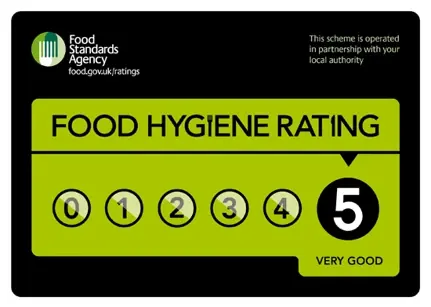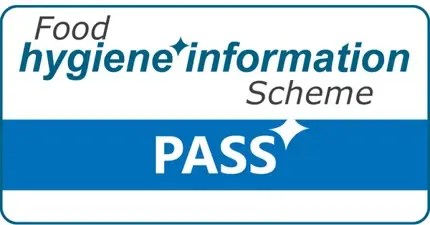How are food hygiene ratings calculated?
It is important to remember that ratings are a snapshot of the standards of food hygiene found at the time of inspection. It is the responsibility of the business to comply with food hygiene law at all times not just at inspection.
Each business covered by the food hygiene rating scheme is inspected during an ‘unannounced’ visit by an Environmental Health Officer. The visit will inspect and assess:
- How food is handled
- How food is stored
- How food is prepared
- Cleanliness of facilities
- How food safety is managed
The food hygiene rating scheme does not provide information on the following factors:
- Quality of the food
- Customer service
- Culinary skill
- Presentation
Comfort
The Environmental Health Officer uses a set procedure to calculate a food hygiene rating. Using the Food Law Code of Practice as a guide, three categories are examined:
- How hygienically is the food handled
- What is the condition of the premises structure
- Management and Documented Procedures
Categories 1 and 2 are scored from 25 (very poor) to 0 (perfect) but category 3 is scored from 30 (very poor) to 0 (perfect).
The scores from each category are added together to then give a food hygiene rating:
- Score 0 - 15 (with no category score more than 5) gives a 5 – hygiene standards are very good
- Score 20 (with no category score more than 10) gives a 4 – hygiene standards are good
- Score 25 - 30 (with no category score more than 10) gives a 3 – hygiene standards are generally satisfactory
- Score 35 - 40 (with no category score more than 15) gives a 2 – some improvement is necessary
- Score 45 - 50 (with no category score more than 20) gives a 1 – major improvement is necessary
- Score over 50 gives a 0 – urgent improvement or intervention is required
Where a category score exceeds the maximum allowed for that particular rating. Then the rating falls to the maximum level at which that category score is allowed. For example, a category score of 15 in any of the three categories would result in a rating of 2. Even if the overall total was 15.
Anybody who has completed our level 2 food hygiene and safety course for catering will probably understand everything needed to get a 5 star rating.
How often are food hygiene ratings done?
A new rating is given every time a local authority food safety officer inspects a food business.
Local authorities plan a programme of inspections every year. The frequency of inspections depends on the potential risk to public health, this will include the following factors:
- Type of food that is handled
- The number and type of customers (are there vulnerable groups involved)
- Types of processes carried out before the food is sold or served
- Hygiene standards seen on the day of the last inspection
Obviously higher risk businesses are inspected more often than lower risk. An example of a low risk business is a small retailer selling a range of prepacked foods that only need to be refrigerated.
The time between inspections varies from six months for the highest risk businesses to two years for lower risk businesses. For some very low risk businesses, the interval between inspections may be longer than two years. There are circumstances where this schedule can vary.
Local authorities can and do monitor businesses in other ways to ensure they are maintaining hygiene standards. If these checks show that hygiene standards may have deteriorated, the officer will carry out an inspection and the business will get a new rating.
If the local authority receives a complaint or new information about a business not due for inspection, and this suggests hygiene standards have fallen. The local authority will investigate and may inspect the business and give it a new hygiene rating.
How do local authorities plan food business inspections?
Using the information given by the business when it registered the following points are allocated.
Type of Food and Method of Handling
- 40 points given for Manufacture of High Risk Foods including product specific premises; Wholesalers/Packers who re-wrap/re-pack High Risk Foods.
- 30 points given for Preparation, cooking or handling open High Risk Foods by Caterers/Retailers except Caterers preparing less than 20 meals per day.
- 10 points given for Handling pre- packed High Risk Foods; and Caterers preparing less than 20 meals per day. Other Wholesale/Distributors not included above. Manufacture or packing food other than High Risk Foods. Low Risk Food such as Filleting, salting, cold smoking fish, retail sale to final consumer.
- 5 points given for Retail handling, Low Risk Food e.g fruit, vegetables, canned and ambient shelf stable product. Any other business not included in the above definitions.
Method of Processing
- 20 points given for Thermal processing or aseptic packing of low acid food. Vacuum & sous vide packing (excluding raw & unprocessed meats & dried foods). Manufacture of cook/chill excluding Caterers. Small scale production of cooked meat products supplying final consumer.
- 0 points allocated if business does none of the above methods of processing.
Consumers at Risk
- 15 points given for Manufacturers of food distributed Nationally or Internationally
- 10 points given for businesses with substantial customers e.g. Superstore, Hypermarket, Airport & Motorway Services Caterers; Manufacturers not included in category above.
- 5 points given for businesses with local trade e.g. High Street or Corner Shop, High Street Supermarket, or Restaurant
- 0 points allocated for businesses supplying fewer than 20 consumers per day
Vulnerable groups
22 points are added if there will be more than 20 persons in a vulnerable group e.g. elderly people, young children, the sick / immuno-compromised. The points are tallied up and then a frequency of inspection of food business premises is drawn up as follows:
- 92 to 196 at least every 6 months.
- 72 to 91 at least every 12 months.
- 42 to 71 at least every 18 months.
- 31 to 41 at least every 24 months.
- 0 to 30 Alternative Enforcement Strategy.
The best way for any registered food business to remain complaint is to have fully trained staff. Online food safety courses are a very cost efficient way of doing this. For more information on all of our food hygiene courses, click here.





